
Pest: Scarab beetles (Asiatic Garden, Japanese, Oriental, Chafers)
Pest/disease identification and lifecycle, most common damage symptoms and crops affected:
There are several species of scarab beetles that are common in New England turf, fruit and vegetable crops. These were all introduced to the United States. Japanese beetles are the most common and widely distributed. Below are brief descriptions by species.
Asiatic garden beetle (Maladera castanea)
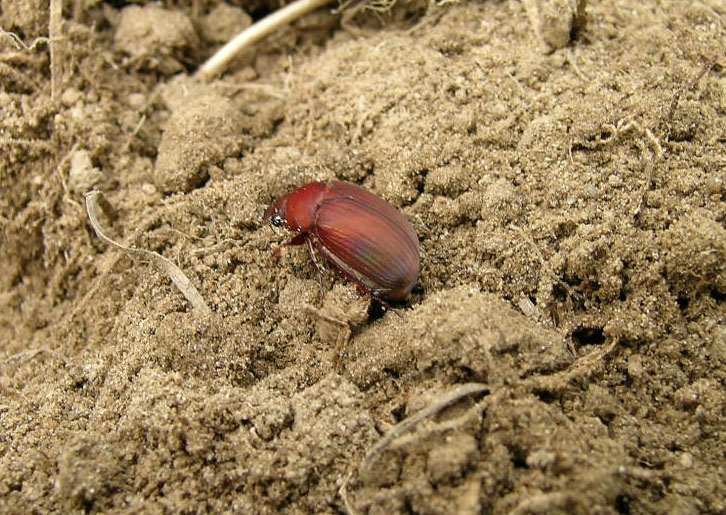
The Asiatic garden beetle is a native of Japan and China where it is not an important pest. The pest overwinters in the soil as a grub feeding on the roots in sod ground and weedy gardens. Some farmers report problems with the grubs in their crop fields (strawberries especially). The larvae (grubs) pupate early in the spring and the resulting adults emerge in June and start feeding on all sorts of garden vegetables, sometimes preferring basil. There is only one generation per year, but the adults feed throughout the summer. The adults are cinnamon to reddish brown, rounded beetles. They eat big and irregular holes in leaves and blossoms. You have to work hard to find them because they feed at night and burrow into the soil for the day. If you see chewed leaves and no pest, then go out at night with a flashlight and see who is there. It will probably be cutworms, or the Asiatic garden beetle.
Cultural management strategies include row cover or exclusion netting (so long as the covered area was free of crop and weed roots for overwintering larvae to feed on). Adult beetles can be hand picked off of plants at night by flashlight which they are attracted to, though be prepared with a container of soapy water held below the plant, as the beetles instinctively drop toward the soil if disturbed.
Pesticides offer some control but often the beetles are very numerous and seem to return from nowhere. Spinosad (Entrust and Monterey Garden Spray) has been reported to work well. A Bt galleriae product (such as beetleGONE! and/or grubGONE!) may help to reduce numbers, and should be less of a risk to beneficials than a spinosad product.
Japanese beetle (Popillia japonica)
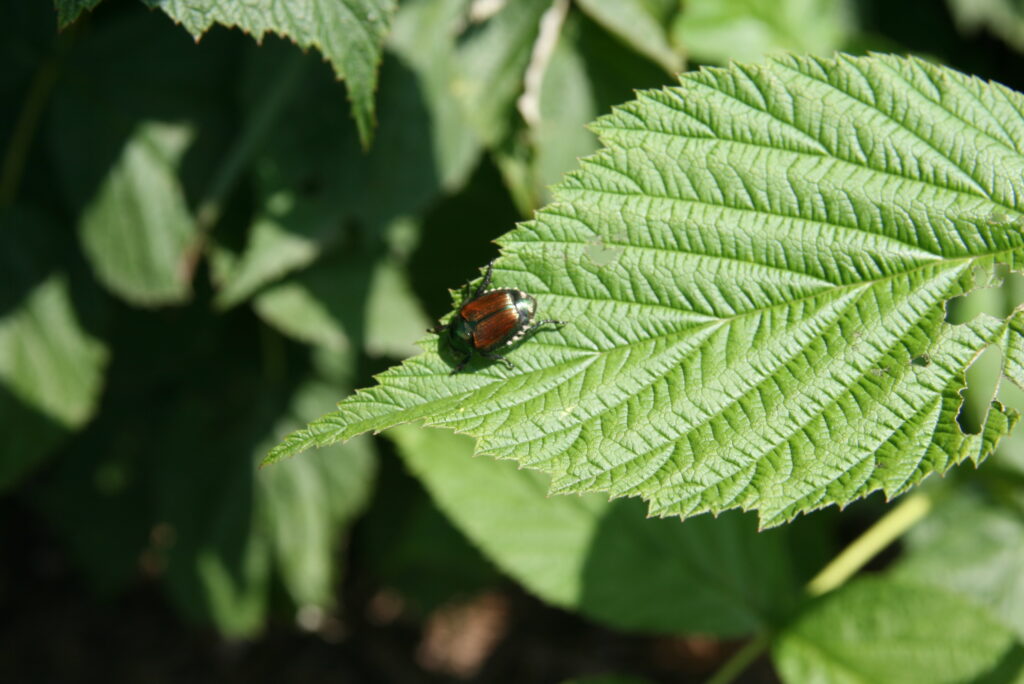
Japanese beetle adults are about half an inch long, with a metallic green head. The wings are shiny copper or bronze in color, and there are a few tufts of white “fur” along the side of each wing when it is folded back over the body. The adults are active in daylight and feed on over 400 different species of trees, fruit and flower crops. Fruit and ornamental plants are preferred, but beetles can congregate in vegetables also. In vegetables, adults can cause silk clipping in corn and leaf damage in sweet basil, leafy greens, green beans, eggplant, asparagus, rhubarb and peppers.
Adult beetles are attracted to brambles (raspberries, blackberries, etc.) and prefer to lay their eggs in lawns, where the larvae can later become a grub problem. There is one generation per year in Maine, and adult populations are most noticeable after emerging in July, slowly reducing in numbers through August. Though numbers may be high, there is no need to treat unless actual feeding damage is significant.
In corn, if there are more than two Japanese beetles per ear and corn is less than 50% pollinated, an application may be warranted to reduce silk clipping and ensure adequate pollination. Adults can be excluded from basil and other greens with row cover or exclusion netting. Because adults are active during daylight hours, these beetles are fairly easy to spot and handpick into containers of soapy water, a practice which can yield surprisingly helpful damage mitigation if done regularly in the evenings starting after adults emerge (perhaps a new after-dinner tradition?). If you notice Japanese beetles with white spots on their back, consider leaving them be, as the spots are likely tachinid fly eggs, which will hatch and parasitize the beetles, killing them. (The larvae that parasitize the beetles will then pupate and turn into flies that will go on to increase the population of insects beneficial to your garden.)
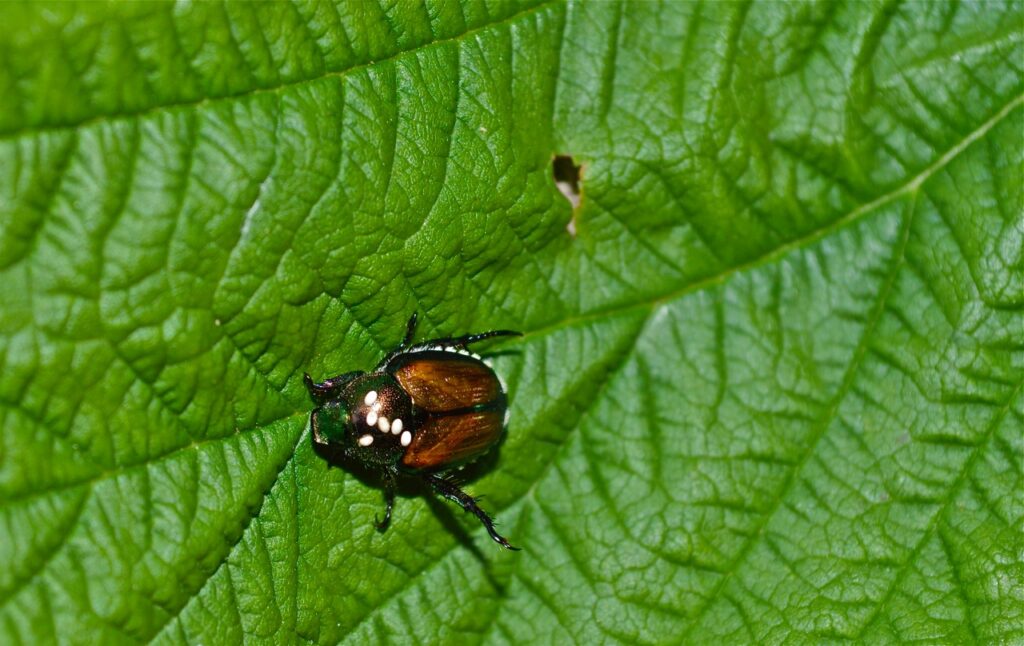
A Bt galleriae product (such as beetleGONE! and/or grubGONE!) may help to reduce numbers, and should be less of a risk to beneficials than other products.
Though it might be satisfying to see a Japanese beetle trap nearly bursting at the seams with captured beetles, the pheromone lure is actually too successful and can draw in beetles from miles around. Many never make it into the traps and begin feeding on nearby plants; females can go on to lay eggs around the area, possibly setting the stage for a population boom the following year. Some gardeners do report success with these pheromone traps, however. If you want to experiment with them, it is recommended to place them as far away as possible from plants that are susceptible to beetle feeding damage.
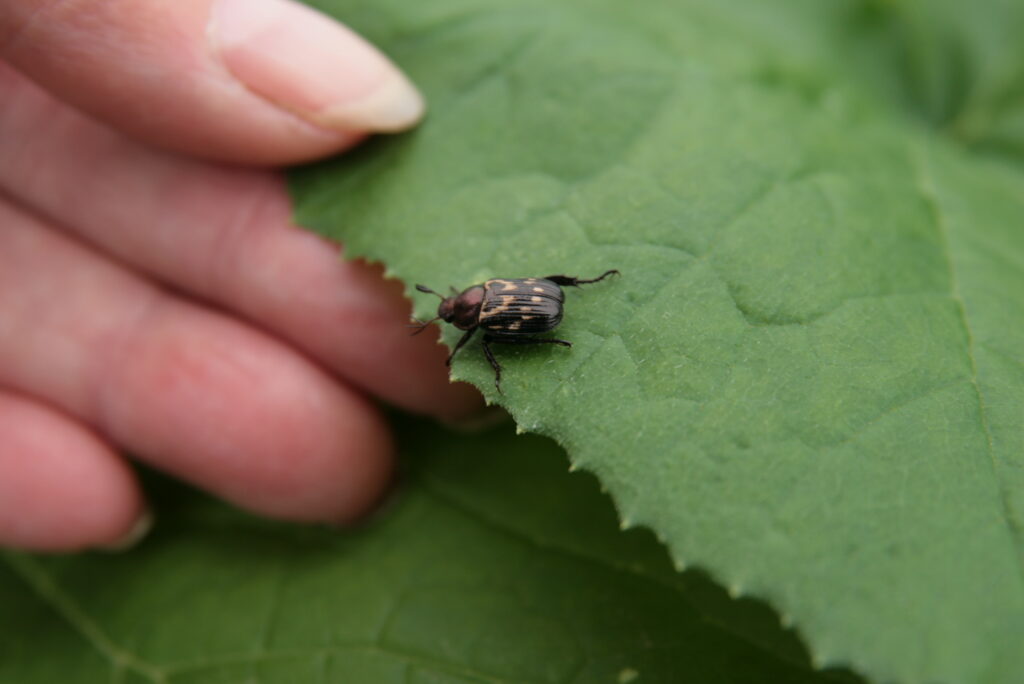
Oriental beetle (Anomala orientalis)
Oriental beetles fly at night, but are very active during the day as well. The beetles are smaller than Japanese beetles, and usually are a rather mottled gray with black splotches. The pattern and color varies. Occasionally an individual will be almost all black or almost all gray. The antennae are branched and are quite striking if you take a close look. Oriental beetles have a long flight period — through early August — and are very mobile. Adults tend not to feed heavily in vegetable crop foliage. Grub damage may be worse in drought years and in weedy fields, but is not commonly a problem in vegetable fields and crops, though this is not well studied.
Two other species are also encountered in the garden or on the farm:
Rose chafer (Macrodactylus subspinosus) have similar lifecycles to Japanese beetles, though they prefer laying eggs in sandy soils and are most likely to become a nuisance in those areas. Adult beetles are about three-quarters of an inch long, and tan to gray in color. Some gardeners use “lure” plants such as Spiraea, Deutzia, Andromeda, blackberries and white roses in the hopes of controlling adult beetles there, before they go on to other small fruit, or ornamental plants. One important warning for home poultry keepers is that rose chafers are toxic to poultry.
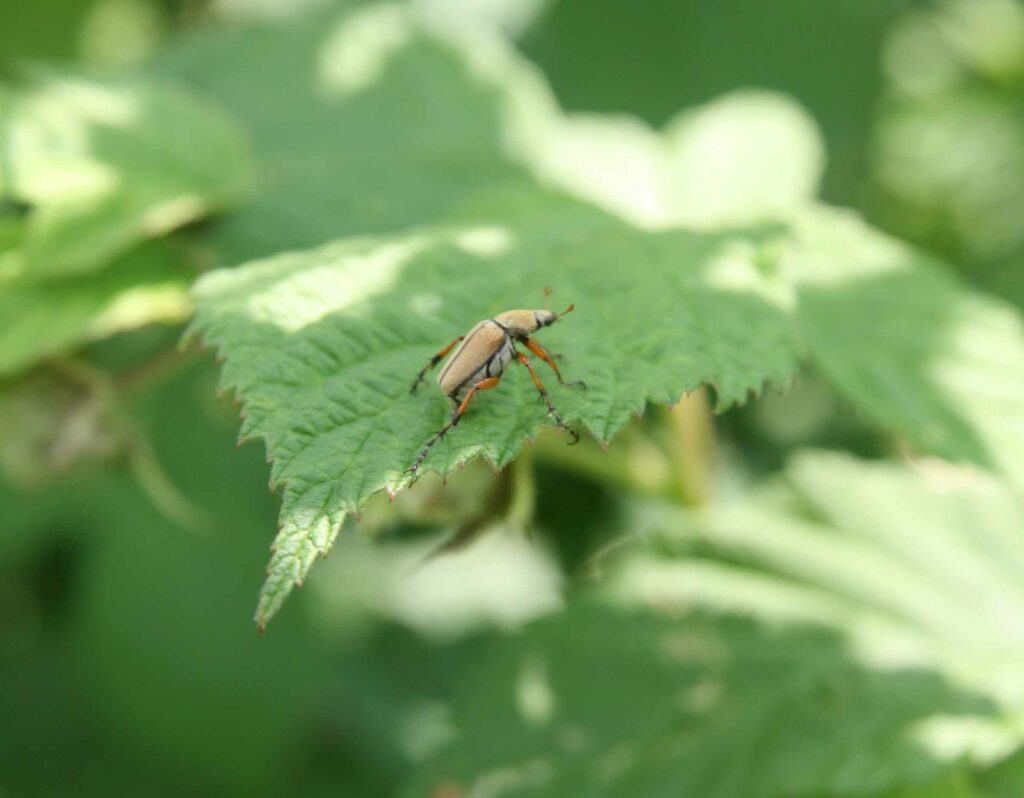
European chafers (Rhizotrogus majalis) are slightly larger than Japanese beetles and are a fairly dull brown or tan in color. They are night fliers but can be seen in large numbers just at sunset, when they congregate in large numbers in favorite trees (such as locust or willow). Adults are not foliage feeders and grubs are mostly a turf problem.
Please note: This information is for educational purposes. Any reference to commercial products, trade or brand names is for information only, and no endorsement or approval is intended. Pesticide registration status, approval for use in organic production and other aspects of labeling may change after the date of this writing. It is always best practice to check on a pesticide’s registration status with your state’s board of pesticide control, and for certified organic commercial producers to update their certification specialist if they are planning to use a material that is not already listed on their organic system plan. The use of any pesticide material, even those approved for use in organic production, carries risk — be sure to read and follow all label instructions. The label is the law. Pesticides labeled for home garden use are often not allowed for use in commercial production unless stated as such on the label.
Source material attribution: Modified from a report in the Umass Vegetable Newsletter.
For more information, visit:
https://extension.unh.edu/resource/asiatic-garden-beetle-fact-sheet
https://extension.unh.edu/resource/beetles-ornamental-plants-fact-sheet

